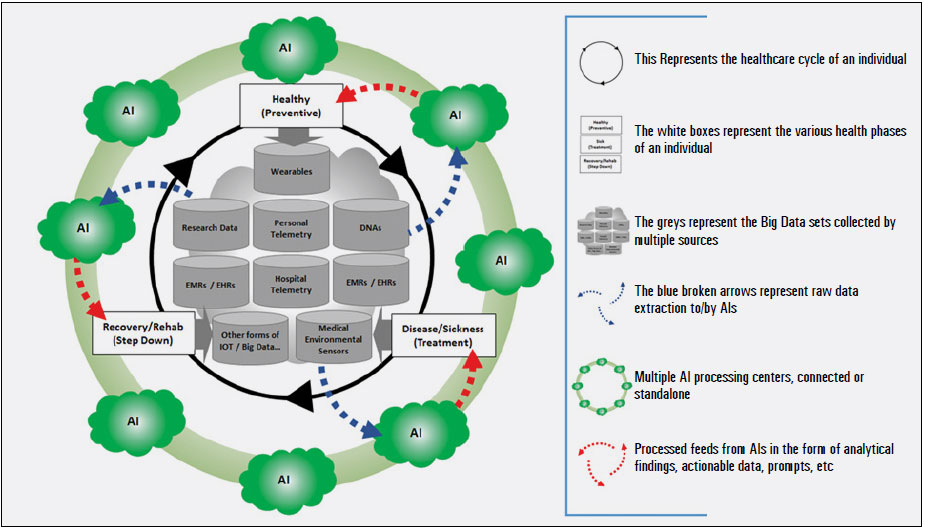THANK YOU FOR SUBSCRIBING
Editor's Pick (1 - 4 of 8)

Machine Learning & Artificial Intelligence in Healthcare Industry
James Woo, CIO, The Farrer Park Company


James Woo, CIO, The Farrer Park Company
c. To predict an onset of a stroke or heart attack in certain patients within the hospital or after discharge. Researchers at the University of Nottingham in UK have created an AI system to scan patient’s routine medical data and predict who would have heart attacks or strokes within 10 years. They are still working with multiple algorithms to find one with the highest predictability. Ultimately, this can be used in a routine consultation, emergency room, or ICU settings.
Disease treatment
Clinical data from EMR (diagnosis, treatments, test results, medication) together with telemetries from medical devices could be used by AI to improve medical diagnosis and recommend treatments to clinicians for their consideration. Two examples of such usage,
a. A MIT professor in collaboration with Massachusetts General Hospital is applying her natural language processing expertise in ML and AI to improve cancer diagnosis and treatment.
b. A US start-up, Path AI participated in an April 2016 challenge pitting their computer against an expert pathologist, in detecting breast cancer – computer had an error rate around 7.5 percent while the expert’s was about 3.5 percent. However, with more data for deep learning, the computer system surpassed the human expert 7 months later.
Recovery & Rehabilitation
Neofect founded in South Korea, created a product called Rapael Smart Glove, an exo-glove with built-in sensors and AI software to help stroke patients to regain their hand mobility. The gamification aspect of their rehabilitation solution allows the patient to use the Glove in conjunction with a Rapael app to play up to 45 rehabilitation games with varying degree of difficulty.
Disruption
Talking about disruption, there is one area which AI could be extremely disruptive particularly in primary care where one goes to their doctor for their common cough and cold sickness and/or chronic disease management follow ups. Can you imagine the day when someone with common cough and cold uses a mobile app to interact with a clinical bot driven by AI which can diagnose their condition, prescribe test and/or medication based on the symptoms entered into the app, facial recognition and/or past history? And, the patient can pick up their medication from the nearest pharmacy, or get it delivered to their house.
For a large country with limited access to clinical facility in the rural areas, such use of AI through a kiosk might not be such a bad idea. Same goes for chronic disease patient’s routine follow ups, and re-prescriptions. Perhaps we can start off by implementing a hybrid model by having online AI medical assistant bots carry out the diagnosis and with its recommendations being reviewed and endorsed by a human doctor before further steps could be taken – utilising the joint power of human and AI to address the shortage of clinical manpower and facility.
 Moving Forward
There is definitely a role for AI to contribute in the healthcare space, and should we fear the human race being superseded by AI. Then we should confront these fears and work harder to discover and create the controls. And enable artificial intelligence to contribute safely to human’s wellbeing.
Check out: Top Artificial Intelligence Solution Companies in Europe
Moving Forward
There is definitely a role for AI to contribute in the healthcare space, and should we fear the human race being superseded by AI. Then we should confront these fears and work harder to discover and create the controls. And enable artificial intelligence to contribute safely to human’s wellbeing.
Check out: Top Artificial Intelligence Solution Companies in Europe
 Moving Forward
There is definitely a role for AI to contribute in the healthcare space, and should we fear the human race being superseded by AI. Then we should confront these fears and work harder to discover and create the controls. And enable artificial intelligence to contribute safely to human’s wellbeing.
Check out: Top Artificial Intelligence Solution Companies in Europe
Moving Forward
There is definitely a role for AI to contribute in the healthcare space, and should we fear the human race being superseded by AI. Then we should confront these fears and work harder to discover and create the controls. And enable artificial intelligence to contribute safely to human’s wellbeing.
Check out: Top Artificial Intelligence Solution Companies in Europe











